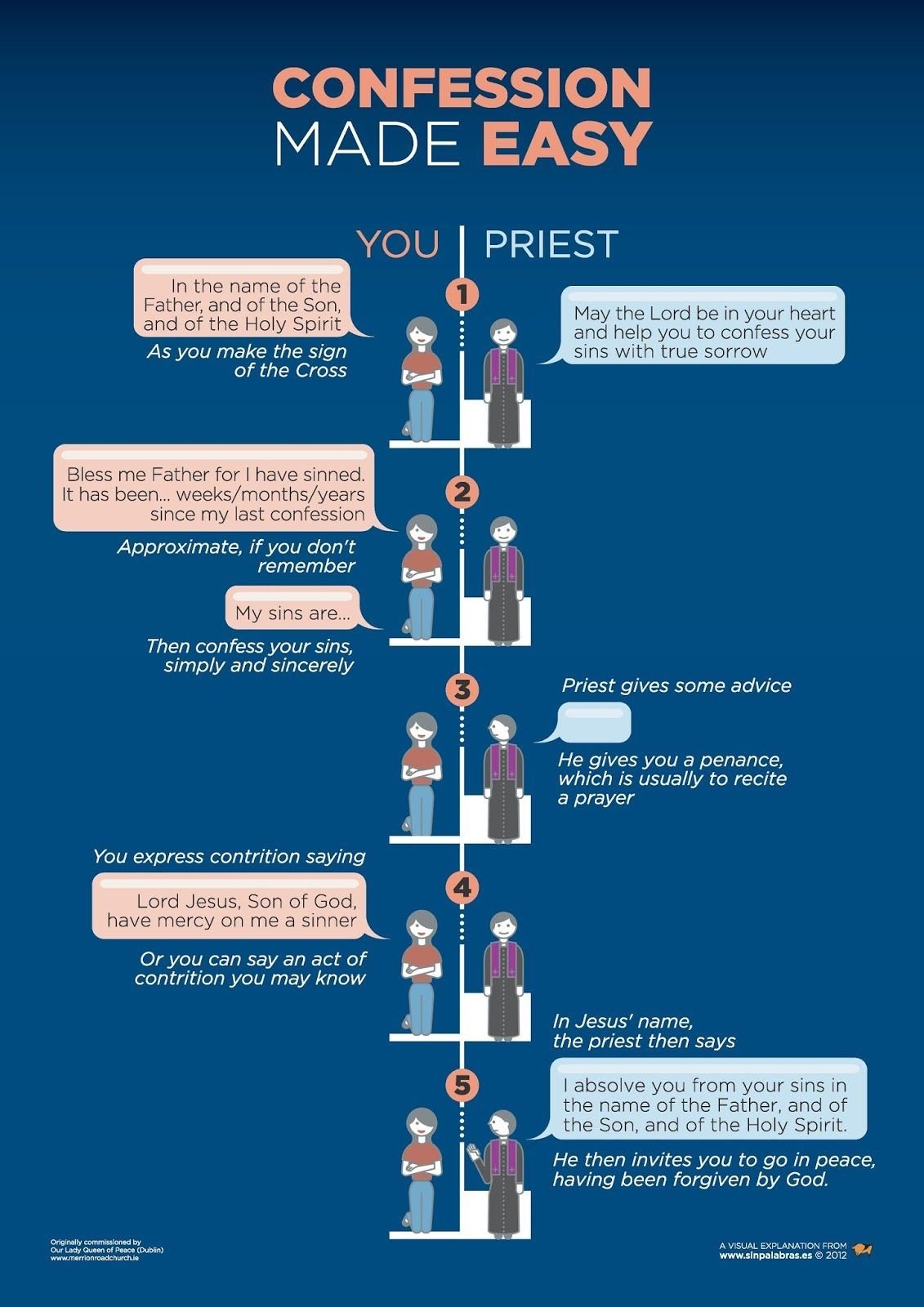Until a retreat this June, I had avoided Reconciliation for quite some time. (Let’s just say that it wasn’t weeks or months!)
The reasons for the delay were pathetic. As the absence grew, the baggage grew and the shame grew! Also, I dislike going to Confession with my parish priests. In my home parish I have known 6-7 P.P.’s. I didn’t want to ruin things with the ones I liked and yet it was even harder to attend the ones I disliked!
The simplest alternative would have been an anonymous confession at the annual Reconciliation Service. These happen in our parish every year shortly before Easter when several priests visit on the same evening. This allows many parishioners to attend Reconciliation in one go and ‘Git’r Dun!’ No idea why I didn’t go there!
Wanting anonymity is probably the wrong attitude! Every priest hearing confession does so as a conduit for the saving grace of Our Lord, Jesus Christ.
There are many wounded people in the Church who are avoiding the sacraments or have stopped coming altogether. Some have taken offense with the Church’s teaching on LGBT, divorce, abortion, etc. There are others with very grievous injuries — the victims of sexual abuse perpetrated by a priest. Non-abused Catholics have also been hurt by this gross breach of trust.
In Canada, many children from First Nations were abused after the government forced them into the Residential School system. (The Catholic Church operated about 50 of the 80 schools.) Thankfully, there is hope for some Reconciliation with First Nations: the Holy Father is visiting Canada in July to apologise to their communities.
It is heartening to know that the Holy Father has a personal confessor: that he can be a sinful person should make it easier for the rest of us to ‘fess up!’
Pope Francis gives some great advice:
It’s not a torture chamber where you’ll be raked over the coals!
Confession is an encounter with Jesus whose “mercy motivates us to do better.”
Confession “is going to praise God, because I — the sinner — have been saved by him,” who always waits and always forgives “with tenderness.”
For exact requirements about the Sacrament of Penance, please review the Catechism of the Catholic Church and Canon Law. (Book IV; Part I; Title IV ‘The Sacrament of Penance’ [959–997]) Code of Canon Law: Table of Contents (vatican.va)
Confession for Dummies
First, we should remember that our darkest secrets are safe in the confessional. Not only have Priests have heard every sin, time after time after time (!) but if there was something that ‘spicy’ the priest is automatically and immediately excommunicated as soon as he knowingly breaches the confessional. (Can. 1388 §1. “A confessor who directly violates the sacramental seal incurs a latae sententiae excommunication reserved to the Apostolic See…”)
“Confession” has evolved into the process of Reconciliation because we should not just rattle off our sins as if we are getting a quick dry-cleaning. We should attend with a contrite heart and reconcile with God. There are many on-line resources to help a rusty penitent make a good Reconciliation. (Some I used recently and have parsed below!)
Simple steps to making a good confession:
· Examine your conscience carefully.
· Be sorry.
· Confess your mortal sins.
· Do the penance! (NB: A requirement for absolution!)
Examination of Conscience:
A proper examination can be quite difficult! Many start with a review of the 10 commandments, but most of us should add a long review of those rather enjoyable Deadly Sins too! (Gluttony; Lust/Fornication; Avarice/Greed; Despair; Wrath; Sloth; Envy; Pride/Hubris.)
Despair can be a sneaky one. Did I delay going for Reconciliation out of a doubt about the Lord’s forgiveness? We can doubt ourselves — we may never doubt His saving grace.
Format of a ‘Confession’:
The Merrion Road Church, Dublin (Our Lady Queen of Peace Parish) has a neat handout for quick reference on to how to make an actual confession. They have tailored this for 3 different stages of life: Adult, Teen and Child. They also provide a ‘cheat sheet’ for examination of conscience at each age level also. The full document is 6 pages (One double sided sheet for each age range.)
From www.sinpalabras.es
The charts are available for download here.
(The designers, www.sinpalabras.es, allow them to be printed, forwarded or electronically published. However, they may NOT be modified without prior permission from the designer.) They are also available in other languages here.
Acts of Contrition:
The traditional Act of Contrition:
“O my God, I am heartily sorry for having offended You, and I detest all my sins because I dread the loss of Heaven and the pains of Hell, but most of all because they offend You, my God, Who are all good and deserving of all my love. I firmly resolve, with the help of Your grace, to confess my sins, to do penance, and to amend my life. Amen.”
I prefer the snappy:
“Lord Jesus, Son of God, have mercy on me a sinner.”
Chapel at Mount St. Francis.
A Joyous Penance
I attended the spring men’s Silent Retreat at Mount St. Francis Retreat House (Alberta) because the silence gives me great respite from day-to-day stresses. Retreatants are silent except for prayer, counselling or when attending Reconciliation.
(For more information: Serenity Now — Catholic Arena)
During this retreat I realized it was past time to ‘fess up’ and attend Reconciliation. Three priests, all Franciscan Friars, were hearing Confessions and I went to the first one available. Though penance is generally tailored to the penitent, there is always that apprehension that one might get something tough to complete.
I have no idea whether the penance the priest gave me was his usual type of penance, or whether he perceived that I needed something…more uplifting? Paraphrasing his words, my penance was:
‘A few minutes in the Chapel contemplating the blessings in my life.’
The most joyous penance ever!
The Risen Lord, Mount St Francis Chapel.
Kevin Hay




